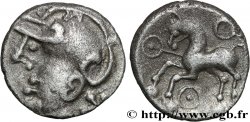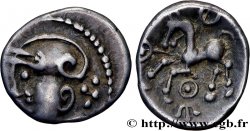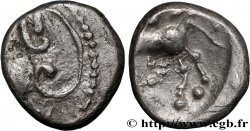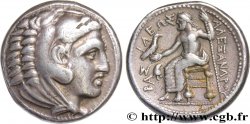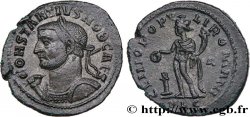v28_0582 - EDUENS, ÆDUI (BIBRACTE, Area of the Mont-Beuvray) Quart de statère en électrum au fleuron
MONNAIES 28 (2007)
Starting price : 350.00 €
Estimate : 750.00 €
Realised price : 939.00 €
Number of bids : 11
Maximum bid : 1 250.00 €
Starting price : 350.00 €
Estimate : 750.00 €
Realised price : 939.00 €
Number of bids : 11
Maximum bid : 1 250.00 €
Type : Quart de statère en électrum au fleuron
Date: c. 70-50 AC.
Mint name / Town : Autun (71)
Metal : electrum
Diameter : 11 mm
Orientation dies : 11 h.
Weight : 1,12 g.
Rarity : R3
Coments on the condition:
Beau petit quart, bien centré, mais assez usé au droit. Tous les détails restent néanmoins identifiables, surtout au revers
Obverse
Obverse legend : ANÉPIGRAPHE.
Obverse description : Tête humaine à gauche, la chevelure stylisée.
Reverse
Reverse legend : ANÉPIGRAPHE.
Reverse description : Cheval galopant à gauche ; derrière, l’aurige au-dessus de la roue du char ; un fleuron sous le cheval.
Commentary
Ce type exact de quart de statère semble maquer à toutes les publications consultées. Cet exemplaire sera illustré comme monnaie type dans le Nouvel Atlas, tome III.








 Report a mistake
Report a mistake Print the page
Print the page Share my selection
Share my selection Ask a question
Ask a question Consign / sell
Consign / sell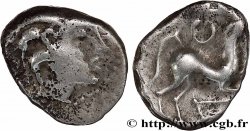
 Full data
Full data